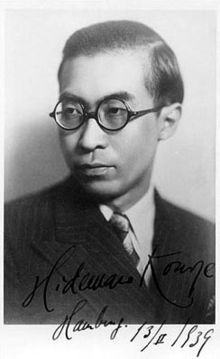Hidemaro Konoye
| Hidemaro Konoye | |
|---|---|

Konoye Hidemaro in 1939 signed photo from Hamburg Philharmonic
|
|
| Native name | 近衞 秀麿 |
| Born |
Hidemaro Konoye 18 November 1898 Kojimachi-ku, Prefecture Tokyo City, |
| Died | June 2, 1973 (aged 74) Noge, Setagaya, Tokyo |
| Other names | Maestro |
| Alma mater | Tokyo Imperial University, Faculty of Arts dropout |
| Occupation | Conductor, composer, music arranger |
| Years active | 1920–1973 |
| Known for | Classical Music |
| Children | Hidetake Konoe Tadatoshi Miyagawa |
| Parents |
|
| Relatives | Tadamaro Miyagawa (brother) Naomaro Konoye (brother) Fumimaro Konoe (brother) |
Viscount Hidemaro Konoye (近衛 秀麿 Konoe Hidemaro?, 18 November 1898 – 2 June 1973) was a conductor and composer of classical music in Shōwa period Japan. He was the younger brother of pre-war Japanese Prime Minister Fumimaro Konoe.
Konoye was born in Kōjimachi, Tokyo as the younger son of Duke Konoe Atsumaro, scion of one of the Five regent houses of the Fujiwara clan. The Konoe clan traditionally provided gagaku musicians to the Imperial Household, and Hidemaro chose to follow the family's musical tradition, whereas his older brother Fumimaro went into politics.
Konoye attended the Gakushuin Peers School, where he became a close friend of Takashi Inukai. In 1913, he entered the Tokyo University of the Arts, where he specialized in the violin. In 1915, he went to Germany briefly to study musical composition. On his return to Japan he became a pupil of Kosaku Yamada. His debut as a conductor was in 1920, with an amateur orchestra led by Tokichi Setoguchi. Konoye returned to Europe for further studies in 1923 in Paris under Vincent d'Indy and Berlin under Franz Schreker. He also studied conducting under Erich Kleiber, and Karl Muck. In 1924, he conducted at the Berlin Philharmonic, and returned to Japan in the fall of the same year.
...
Wikipedia
